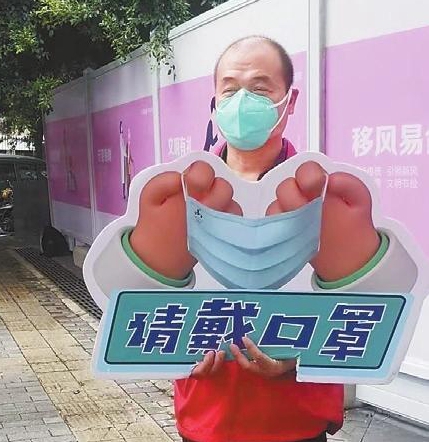Proper mask-wearing critical
Writer: Wang Jingli, Huang Jieqi | Editor: Liu Minxia | From: Shenzhen Daily | Updated: 2022-09-02
A+ A- Print
Most COVID cases discovered recently in Shenzhen since Aug. 23 were identified having BF.15, a new mutation of the Omicron subvariant BA.5.2.1, according to the Shenzhen Center for Disease Control and Prevention (CDC).
BF.15 is highly homologous to a virus sequence uploaded by Hong Kong’s Department of Health in July, according to Lu Hongzhou, president of the Third People’s Hospital of Shenzhen. Information about BF.15 is limited so its virology and clinical features need to be further studied, he said.
Wearing a mask scientifically and correctly is still an effective way to curb the spread of the coronavirus, because it can reduce the risk of infection by more than 80%, experts from the Shenzhen CDC said.

A volunteer holds a sign urging people to wear masks near an intersection at Jingtian Road in Futian District on Thursday. Eunice Kang
When wearing a mask, it is important to make sure the mask covers the mouth, nose and chin and adjust the nose clip so that it can fit snugly against the face. Moreover, it is not advised to wear multiple masks at the same time, the experts said.
While taking a nucleic acid test, residents are advised to remove the mask by grabbing the mask’s straps and avoid touching the outside of the mask.
In addition, special care should be taken for special groups. Patients with underlying respiratory diseases need to use protective masks under a doctor’s guidance.
Infants under the age of 3 should not wear masks to prevent a suffocation and parents should avoid taking their children to crowded public places.
It is recommended that disposable masks should be replaced every four hours. This is because the moisture exhaled will make the inner part of the mask wet, which greatly reduces the mask’s filtering effect on bacteria and viruses.
Before putting on and after taking off the masks, people should be careful about hand hygiene by washing hands with soap under running water or rubbing them with a hand sanitizer.
It is not recommended to reuse masks that have been used on inter-regional public transport or in hospitals. If one feels any discomfort such as suffocation or shortness of breath when wearing a mask, remove it immediately outdoors or in an open and ventilated area.
People who sweat a lot should take a few extra masks and replace them in time to prevent them from getting wet and reducing their effectiveness.
When traveling on buses, subways and other public transport, one can wear a disposable or surgical mask, but it is better to wear a surgical mask when having symptoms such as fever and cough.
